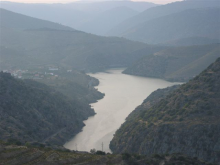 Since a recent visit to Portugal I am watching closely the rise of wines from the Douro Valley. I refer not to the world-class Port wines produced in the region, but the mushrooming legion of red table wines that are beginning to find a following.
Since a recent visit to Portugal I am watching closely the rise of wines from the Douro Valley. I refer not to the world-class Port wines produced in the region, but the mushrooming legion of red table wines that are beginning to find a following.
The Douro Valley is one of the world’s most strikingly beautiful wine regions, and perhaps its most rugged. Vines are planted on steep hillsides that elevate dramatically from the banks of the Douro river. First and foremost, these vineyards are difficult to farm. There is very little rain. The soils are so poor there is virtually no other agricultural crop. And daytime temperatures frequently top 100 degrees in the middle of the growing season.
 What could be better for the production of exceptional wine grapes? Indeed, the red wines of the region are distinctive and powerful. Many are produced from 70- to 100-year-old vines, with indigenous grape varieties such as Touriga Nacional, Touriga Franca, Tinta Cao, Tinta Barroca and the Spanish variety, Tinta Roriz (Tempranillo).
What could be better for the production of exceptional wine grapes? Indeed, the red wines of the region are distinctive and powerful. Many are produced from 70- to 100-year-old vines, with indigenous grape varieties such as Touriga Nacional, Touriga Franca, Tinta Cao, Tinta Barroca and the Spanish variety, Tinta Roriz (Tempranillo).
Most of the bottlings from old vines are ‘field blends’ that combine two or more of the indigenous varieties that have been inter-planted in the same vineyard. Yet despite the presence of these old vines, the table wines from the region are a recent development.
 The oldest and most successful of these is Ferreira’s Barca Velha, which was first made in 1952 at Quinta do Vale Meao in the Douro Superior, close to the Spanish border. Barca Velha is only made in exceptional vintages. Though Barca Velha is no longer made at Quinta do Vale Meao, Francisco Olazabal has carried on the tradition of table wines at the estate with his son, also Francisco, who is the winemaker.
The oldest and most successful of these is Ferreira’s Barca Velha, which was first made in 1952 at Quinta do Vale Meao in the Douro Superior, close to the Spanish border. Barca Velha is only made in exceptional vintages. Though Barca Velha is no longer made at Quinta do Vale Meao, Francisco Olazabal has carried on the tradition of table wines at the estate with his son, also Francisco, who is the winemaker.
The new leadership has now produced four vintages, with outstanding results. Further from the Spanish border and closer to Pinhao, the heart of the Douro region, is Quinta do Crasto (pronounced crash-toe), a small, family run winery recently rejuvenated by the Roquette brothers, Tomas and Miguel. Their top wine is a single-vineyard field blend, Maria Teresa, but I also fell in love with their promising single-varietal Touriga Nacional, which I tasted in July.
 The Nieport family, more widely known for its colheita tawny Ports and Vintage Ports, has recently dedicated a number of quintas (farms) to the production of table wines. Nieport is considered a leader in this trend.
The Nieport family, more widely known for its colheita tawny Ports and Vintage Ports, has recently dedicated a number of quintas (farms) to the production of table wines. Nieport is considered a leader in this trend.
From my limited tastings during a brief visit in July, it is clear to me that these are some of the most exciting new red wines in the world. It’s only a matter of time before the whispers become a buzz, and then a roar.
8
